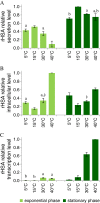Thermal adaptability of Kluyveromyces marxianus in recombinant protein production
- PMID: 23587421
- PMCID: PMC3655038
- DOI: 10.1186/1475-2859-12-34
Thermal adaptability of Kluyveromyces marxianus in recombinant protein production
Abstract
Background: Kluyveromyces marxianus combines the ease of genetic manipulation and fermentation with the ability to efficiently secrete high molecular weight proteins, performing eukaryotic post-translational modifications. It is able to grow efficiently in a wide range of temperatures. The secretion performances were analyzed in the host K. marxianus L3 in the range between 5°C and 40°C by means of 3 different reporter proteins, since temperature appears a key parameter for production and secretion of recombinant proteins.
Results: The recombinant strains were able to grow up to 40°C and, along the tested temperature interval (5-40°C), the specific growth rates (μ) were generally lower as compared to those of the untransformed strain. Biomass yields were slightly affected by temperature, with the highest values reached at 15°C and 30°C. The secretion of the endogenous β-fructofuranosidase, used as an internal control, was efficient in the range of the tested temperature, as evaluated by assaying the enzyme activity in the culture supernatants. The endogenous β-fructofuranosidase production was temperature dependent, with the highest yield at 30°C. The heterologous proteins HSA, GAA and Sod1p were all successfully produced and secreted between 5°C and 40°C, albeit each one presented a different optimal production temperature (15, 40, 5-30°C for HSA, GAA and Sod1p, respectively).
Conclusions: K. marxianus L3 has been identified as a promising and flexible cell factory. In a sole host, the optimization of growth temperatures for the efficient secretion of each individual protein can be carried out over a wide range of temperatures.
Figures




Similar articles
-
SOD1, a new Kluyveromyces lactis helper gene for heterologous protein secretion.Appl Environ Microbiol. 2008 Dec;74(23):7130-7. doi: 10.1128/AEM.00955-08. Epub 2008 Oct 3. Appl Environ Microbiol. 2008. PMID: 18836000 Free PMC article.
-
Kluyveromyces marxianus as a host for heterologous protein synthesis.Appl Microbiol Biotechnol. 2016 Jul;100(14):6193-6208. doi: 10.1007/s00253-016-7645-y. Epub 2016 Jun 3. Appl Microbiol Biotechnol. 2016. PMID: 27260286 Review.
-
Direct fermentation of raw starch using a Kluyveromyces marxianus strain that expresses glucoamylase and alpha-amylase to produce ethanol.Biotechnol Prog. 2014 Mar-Apr;30(2):338-47. doi: 10.1002/btpr.1877. Epub 2014 Feb 12. Biotechnol Prog. 2014. PMID: 24478139
-
Direct ethanol production from cellulosic materials at high temperature using the thermotolerant yeast Kluyveromyces marxianus displaying cellulolytic enzymes.Appl Microbiol Biotechnol. 2010 Sep;88(1):381-8. doi: 10.1007/s00253-010-2784-z. Epub 2010 Jul 31. Appl Microbiol Biotechnol. 2010. PMID: 20676628
-
Kluyveromyces marxianus: An emerging yeast cell factory for applications in food and biotechnology.Int J Food Microbiol. 2020 Nov 16;333:108818. doi: 10.1016/j.ijfoodmicro.2020.108818. Epub 2020 Aug 12. Int J Food Microbiol. 2020. PMID: 32805574 Review.
Cited by
-
The potential of cold-shock promoters for the expression of recombinant proteins in microbes and mammalian cells.J Genet Eng Biotechnol. 2022 Dec 29;20(1):173. doi: 10.1186/s43141-022-00455-9. J Genet Eng Biotechnol. 2022. PMID: 36580173 Free PMC article. Review.
-
Thermal treatment improves a process of crude glycerol valorization for the production of a heterologous enzyme by Yarrowia lipolytica.Biotechnol Rep (Amst). 2021 Jun 19;31:e00648. doi: 10.1016/j.btre.2021.e00648. eCollection 2021 Sep. Biotechnol Rep (Amst). 2021. PMID: 34221911 Free PMC article.
-
Enzymatic hydrolysis of Opuntia ficus-indica cladode by Acinetobacter pittii and alcohol fermentation by Kluyveromyces marxianus: pH, temperature and microorganism effect.Biotechnol Rep (Amst). 2019 Oct 25;24:e00384. doi: 10.1016/j.btre.2019.e00384. eCollection 2019 Dec. Biotechnol Rep (Amst). 2019. PMID: 31763197 Free PMC article.
-
Genetic and physiological basis for antibody production by Kluyveromyces marxianus.AMB Express. 2018 Apr 12;8(1):56. doi: 10.1186/s13568-018-0588-1. AMB Express. 2018. PMID: 29651657 Free PMC article.
-
Safety Assessment of 3S, 3'S Astaxanthin Derived from Metabolically Engineered K. marxianus.Antioxidants (Basel). 2022 Nov 18;11(11):2288. doi: 10.3390/antiox11112288. Antioxidants (Basel). 2022. PMID: 36421474 Free PMC article.
References
-
- López-Alvarez A, Díaz-Pérez AL, Sosa-Aguirre C, Macías-Rodríguez L, Campos-García J. Ethanol yield and volatile compound content in fermentation of agave must by Kluyveromyces marxianus UMPe-1 comparing with Saccharomyces cerevisiae baker’s yeast used in tequila production. J Biosci Bioeng. 2012;113(5):614–618. doi: 10.1016/j.jbiosc.2011.12.015. - DOI - PubMed
MeSH terms
Substances
LinkOut - more resources
Full Text Sources
Other Literature Sources
Research Materials
Miscellaneous

